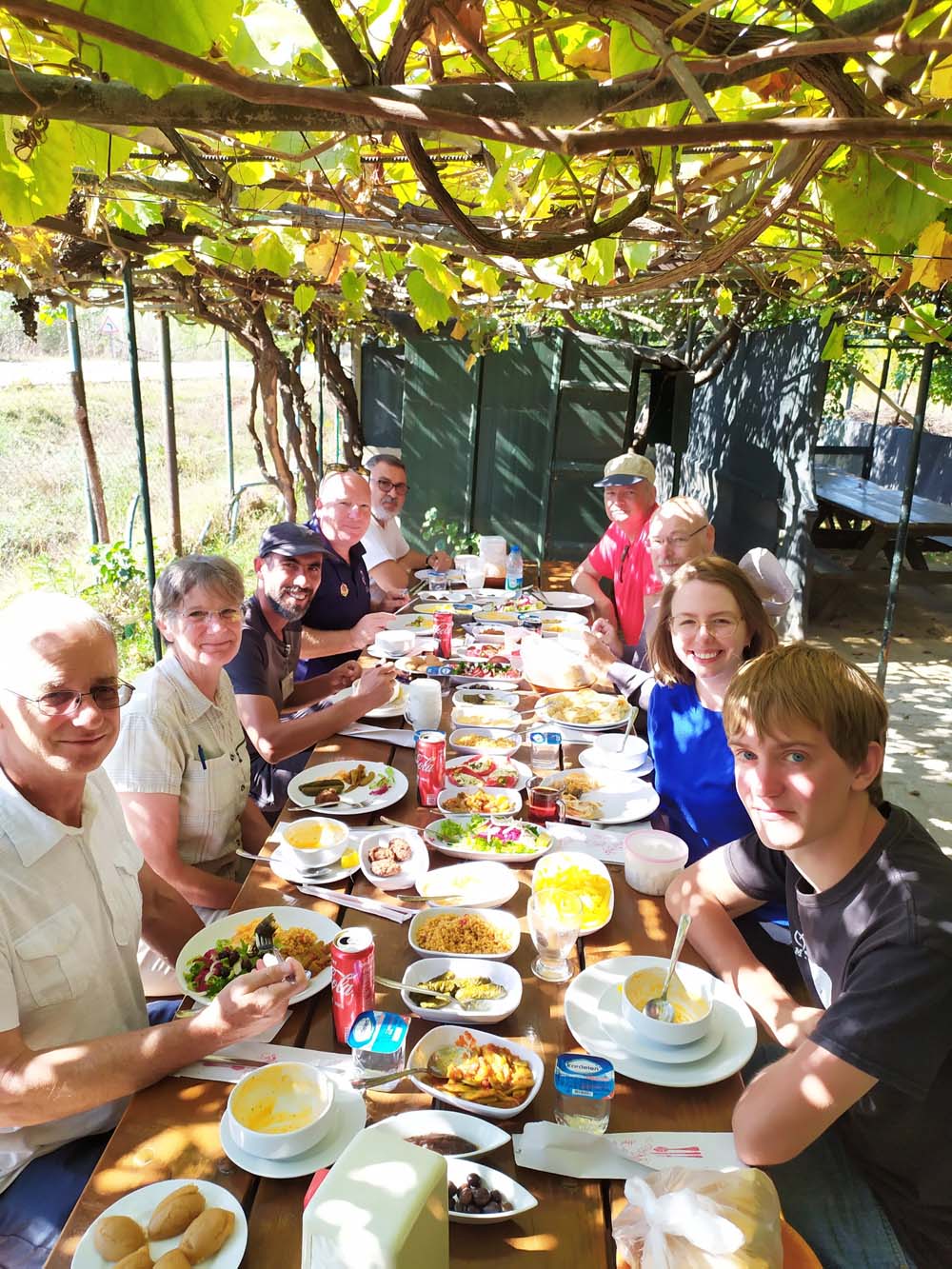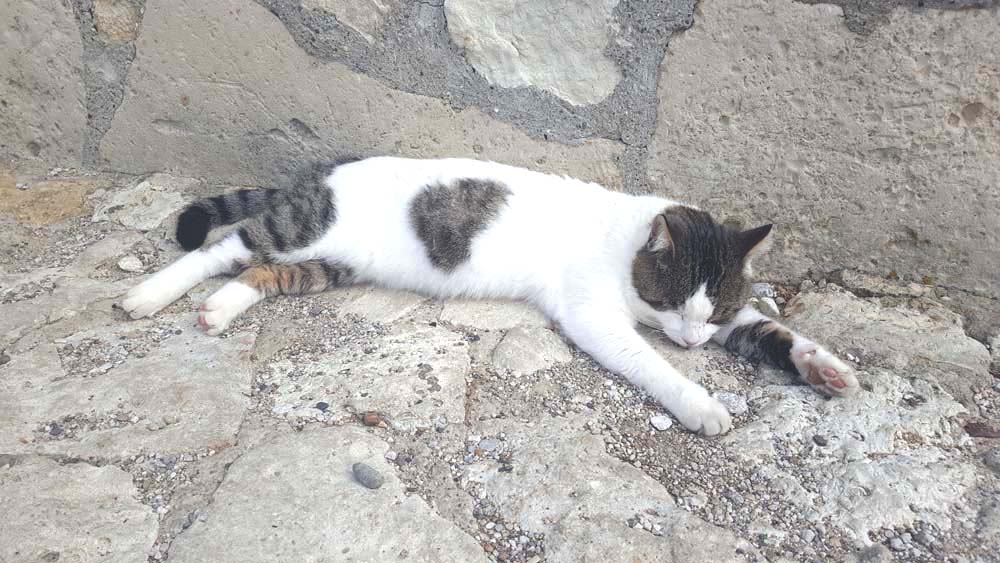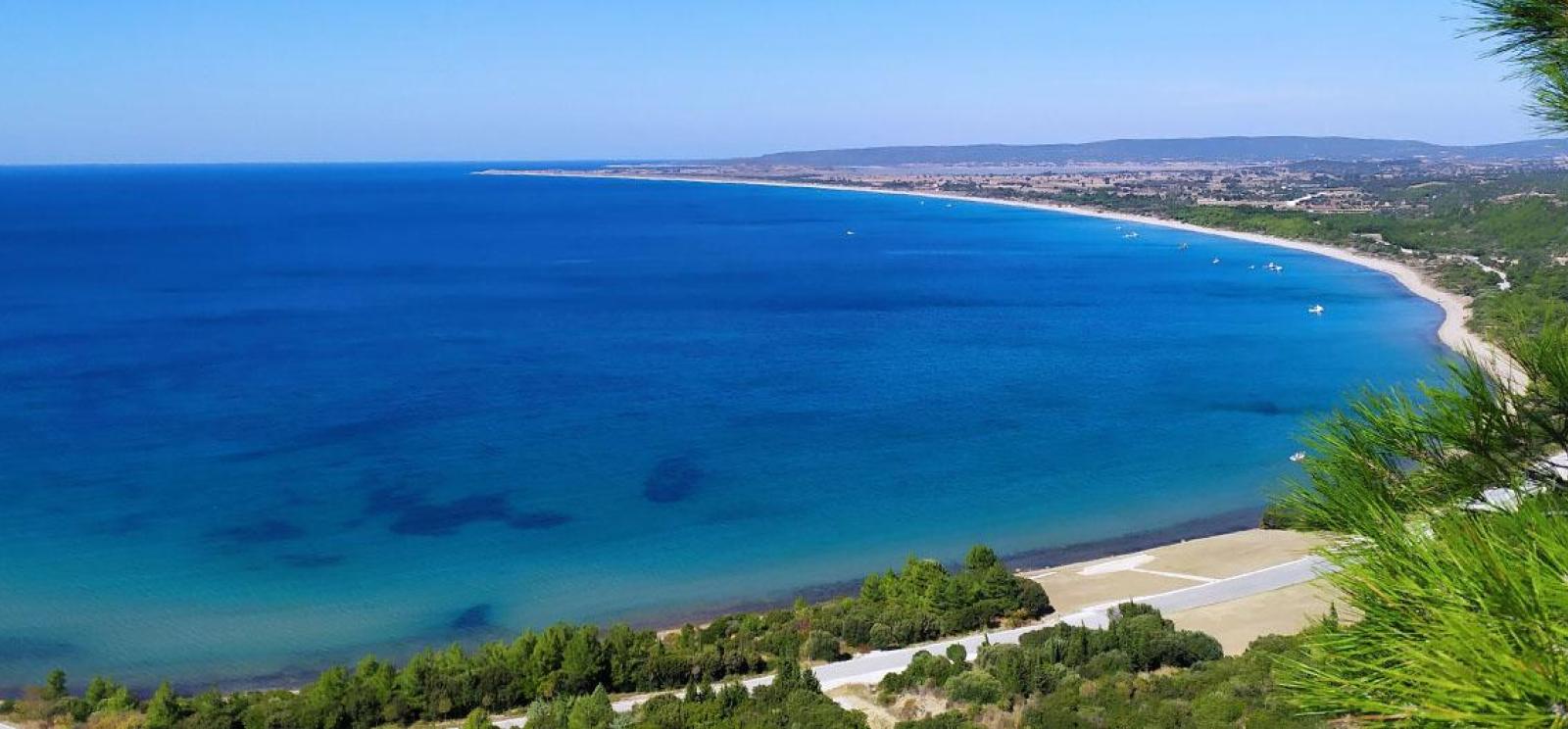No battlefield is as dramatic in setting, nor as evocative in memory, as Gallipoli. The National WWI Museum and Memorial embarked on an intimate tour of the Turkish peninsula in 2019, tracing the route of the Allied forces in the Gallipoli Campaign from landing to evacuation.
National WWI Museum and Memorial Learning Coordinator Haley Sheriff shares her day-to-day experiences on this journey.
Arrival: Istanbul
At the crossroads of two continents, Istanbul feels neither wholly European nor Asian, nor more one than the other. Its rhythm and color is uniquely its own. The heart of the Eastern Roman Empire, Byzantium, then Constantinople and—officially since 1930—Istanbul, is a city of many different names, host and home to many different peoples and cultures.
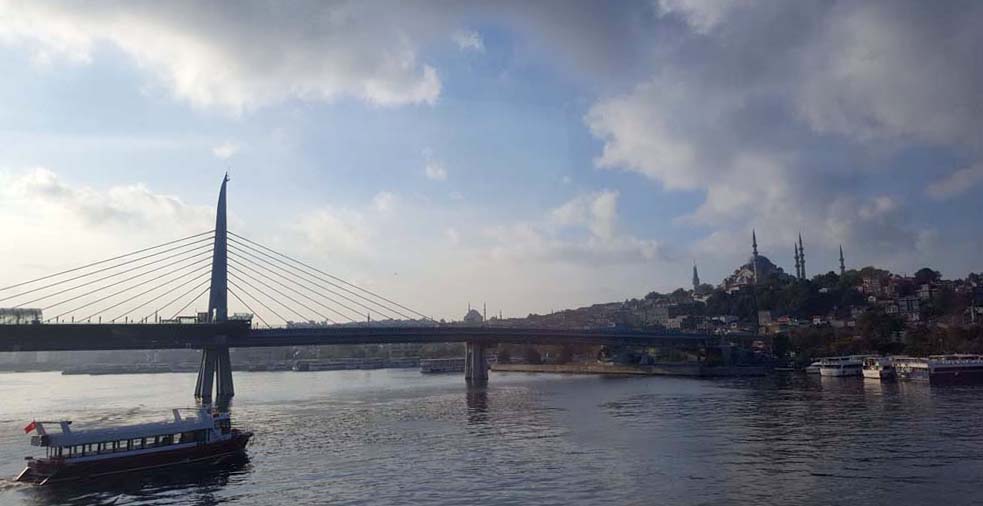
Staying in Sultanahmet, Istanbul’s oldest neighborhood, National WWI Museum and Memorial Battlefield Tour participants were within walking distance of some of the world’s most famous landmarks like Hagia Sophia, Topkapı Palace and the Blue Mosque. From morning to evening, the aroma of grilled corn, roasted chestnuts, Nutella-slathered simit (a popular local pastry) and fresh squeezed citrus juices wreath through the narrow streets from food vendors throughout the square.
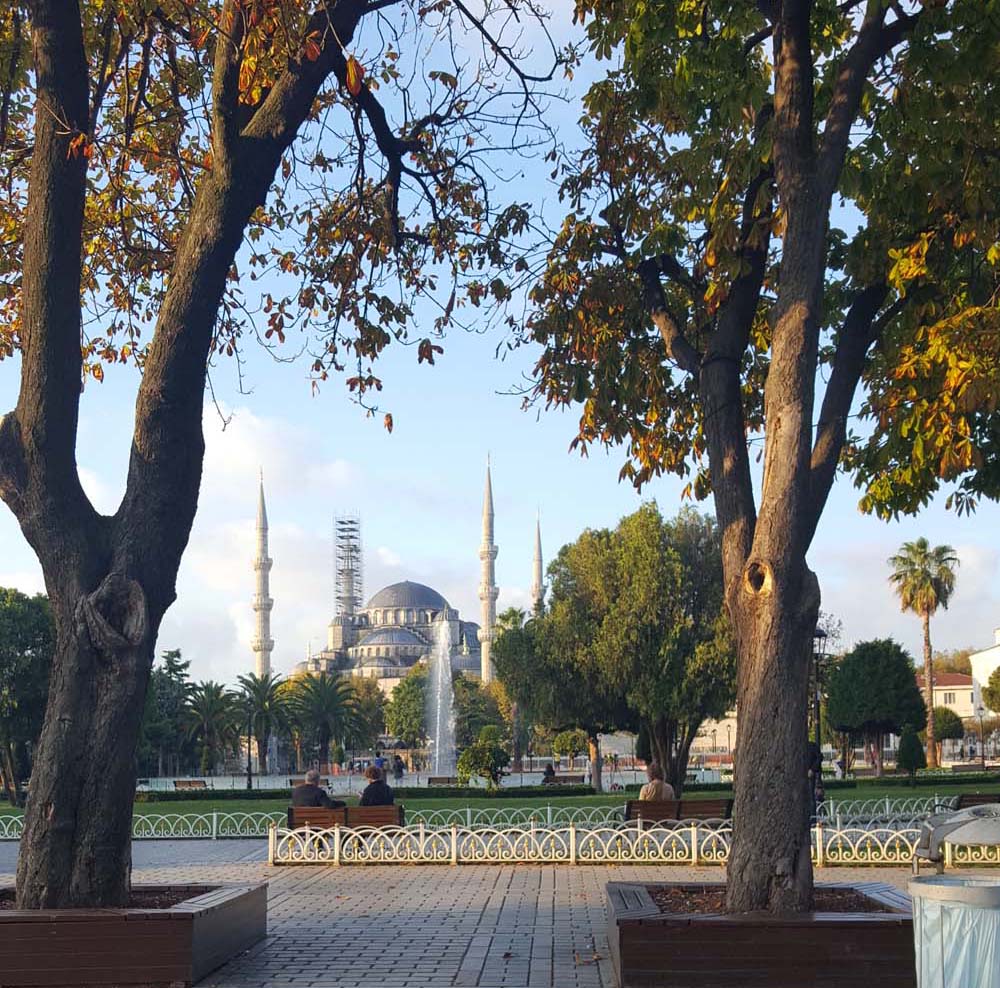
From the local bazaar’s rainbow display of lokum (Turkish Delight) to the single blue eye amulets (nazar) that peer from walls and doorframes —there is not a grey corner in the city.
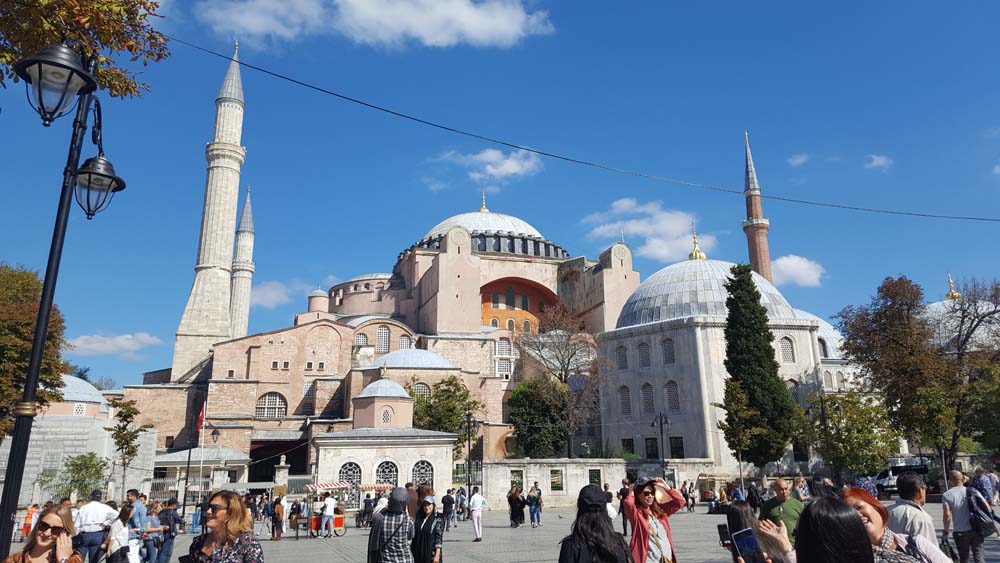
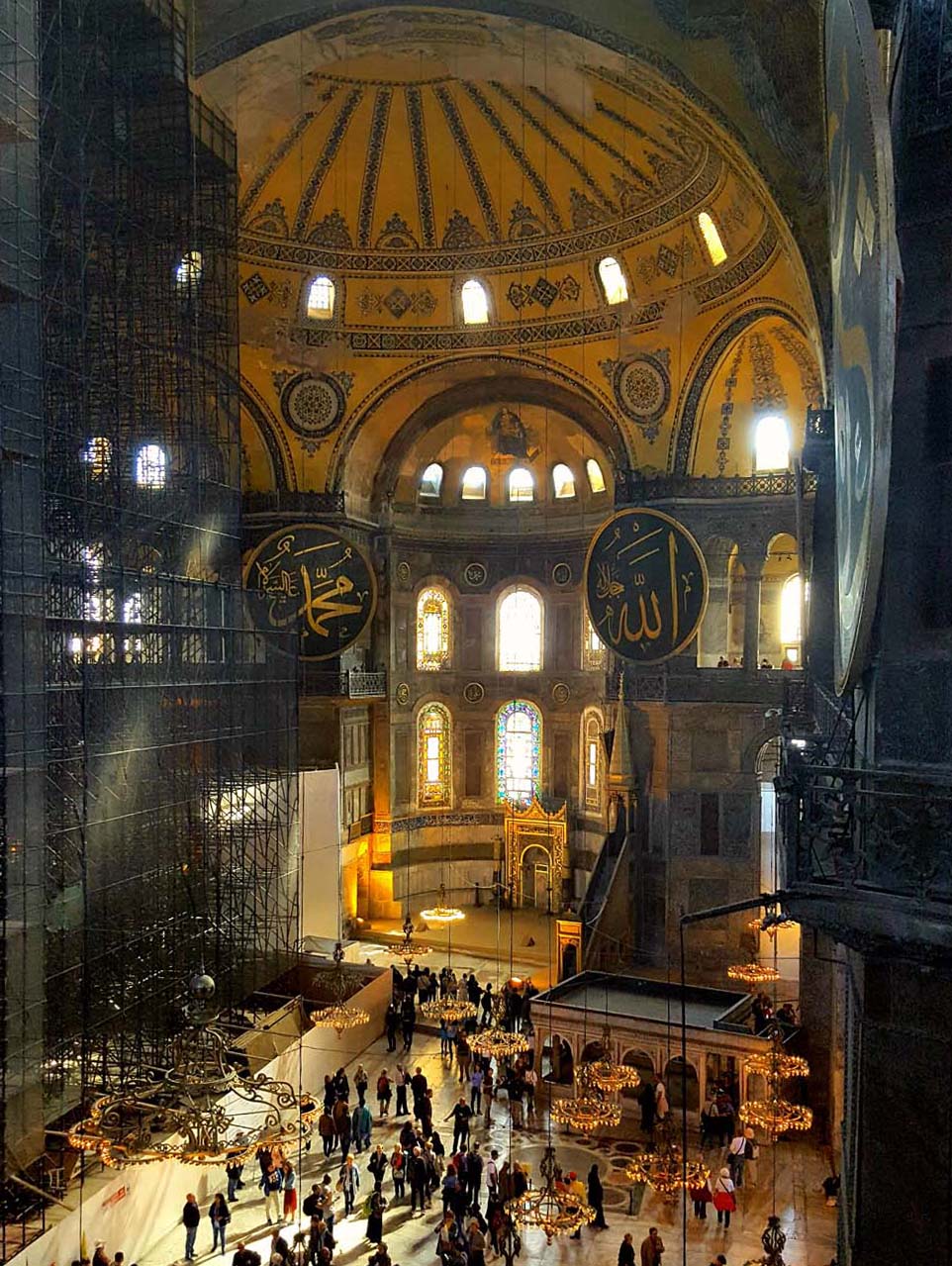
Istanbul was magical, but merely a glimpse of what was to come of our journey in Çanakkale during the next five days.
Day 1: Istanbul to Çanakkale
Our tour of Gallipoli began the same day as a Turkish military offensive in northern Syria. “We will be studying war in the midst of war,” Clive Harris, our guide, noted while we sipped steaming çay, a robust dark tea, in a cozy restaurant at the Istanbul airport. Indeed, the borders drawn for the Middle East by the Allies during World War I are a source of continued turmoil that, though far away, felt a particularly close on this particular morning. History’s echo was deafening.
This was the first visit to Turkey for each participant, all believing a battlefield tour to Gallipoli would be a great introduction to the country. This tour would mark Clive’s 71st visit to the nation.
Also joining and leading our group was Adem Biçer, a Turkish guide from the Turkish Union of Tourist Guides Chambers (TUREB). Being an executive board member responsible for national training and assignments of newly certified guides for the Turkish government, Adem is among the best.
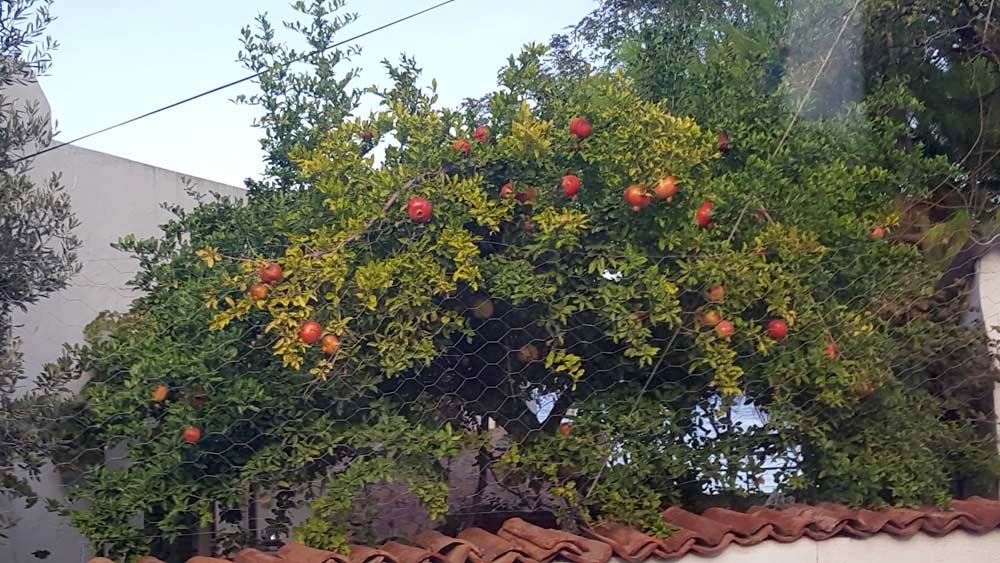
We drove roughly three hours from Istanbul to Tekirdağ for lunch. For our first meal together we had köfte, meatballs typically made from spiced beef or lamb, served with a side of sliced tomato and onion, roasted green peppers and heaping bowls of french fries and bread. We ate so well for lunch each day most participants weren’t ever hungry for dinner!
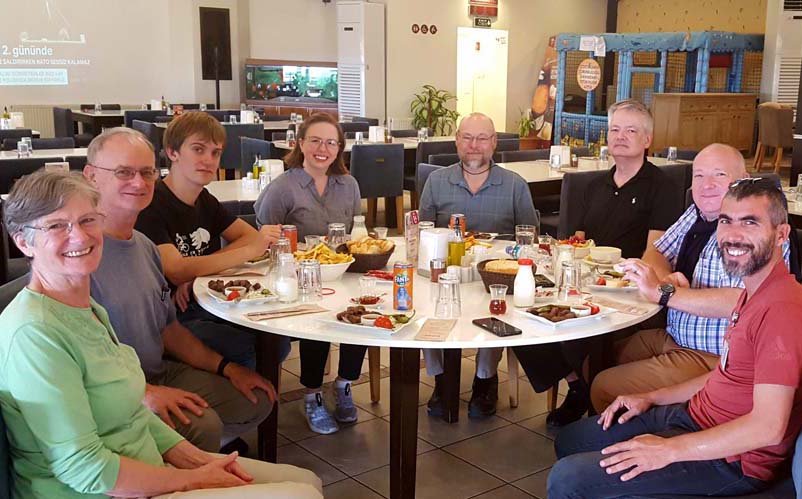
A couple of hours later we arrived at the ferry that would transfer us eastward across the Dardanelles to Çanakkale. After checking in at our hotel and a quick briefing on the strategic importance of this region during World War I, we ended the day orienting ourselves with the city. As we strolled the waterfront, we caught our first sighting of a memorial to the Ottomans who fought in Gallipoli: the white lettering of “Dur Yolcu” (“Stop wayfarer” in English) on the hillside across the bay glowed in the waning sunlight. This message, the opening lines to a poem by Necmettin Halil Onan, would greet us on our way to the Gallipoli peninsula every morning.
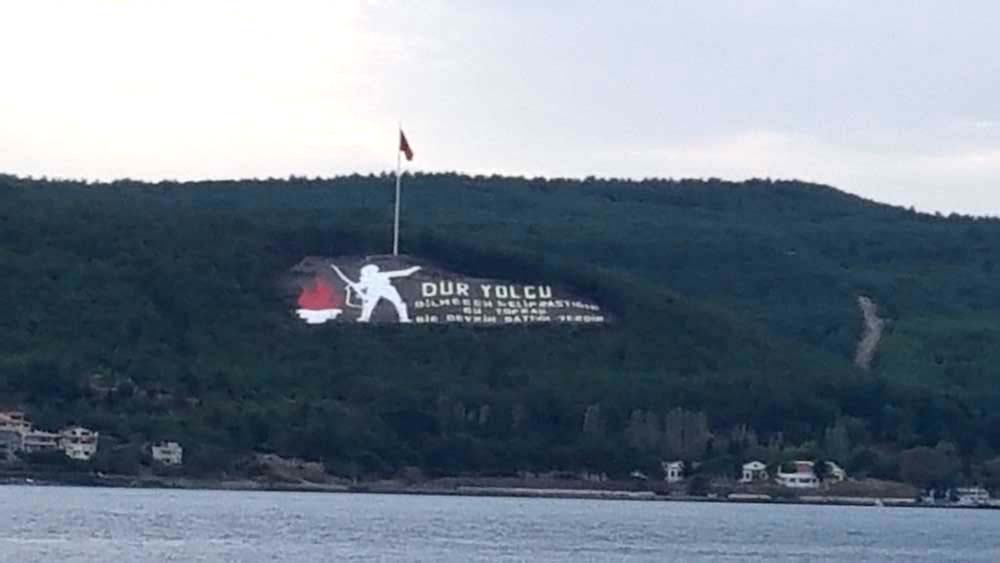
Stop wayfarer! Unbeknownst to you this ground
You come and tread on, is where an epoch lies;
Bend down and lend your ear, for this silent mound
Is the place where the heart of a nation sighs.
To the left of this deserted shadeless lane
The Anatolian slope now observe you well;
For liberty and honour, it is, in pain,
Where wounded Mehmet laid down his life and fell.
This very mound, when violently shook the land,
When the last bit of earth passed from hand to hand,
And when Mehmet drowned the enemy in flood,
Is the spot where he added his own pure blood.
Think, the consecrated blood and flesh and bone
That make up this mound, is where a whole nation,
After a harsh and pitiless war, alone
Tasted the joy of freedom with elation.
On the hill opposite was another message: “18 March 1915,” the date of the Allies’ unsuccessful naval attack to seize the Dardanelles. Control of the waterway by the Royal and French Navies would provide a direct supply route for Imperial Russian forces in the Black Sea, further supporting and expanding Allied presence in the region. Underwater mines and volatile currents, combined with battery fire from Ottoman forts onshore, weakened the fleet and foiled the plan. Their next step was to try to take the Straits by land.
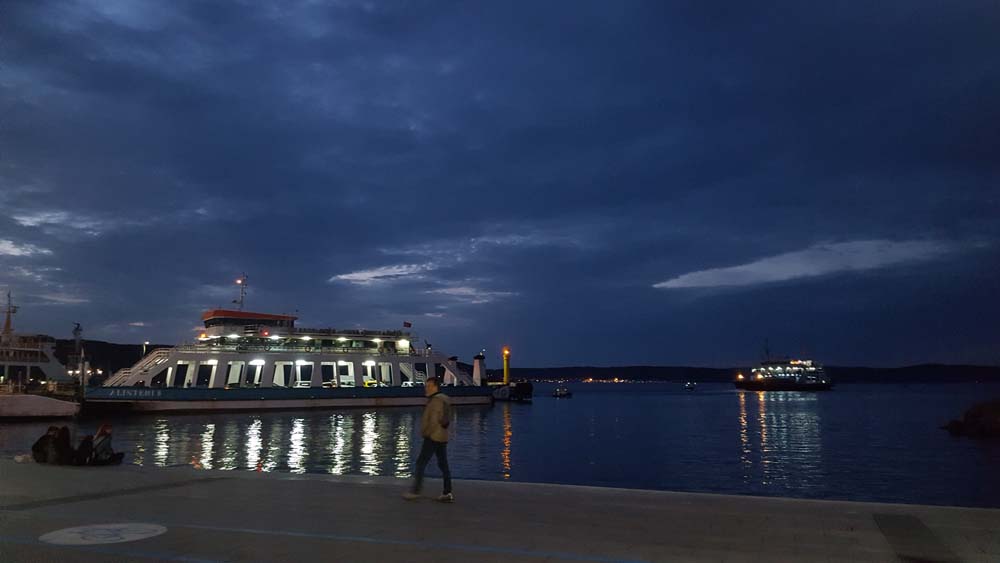
Day 2: Cape Helles
Salty white cheese, fresh tomatoes, briny olives and hot crusty bread are staples of a Turkish breakfast. Though fruit and marmalades are also commonly eaten, the first meal of the day is preferably savory than sweet. The hotel’s buffet further offered lentil soup and menemen, spiced scrambled eggs sautéed with tomatoes and peppers.
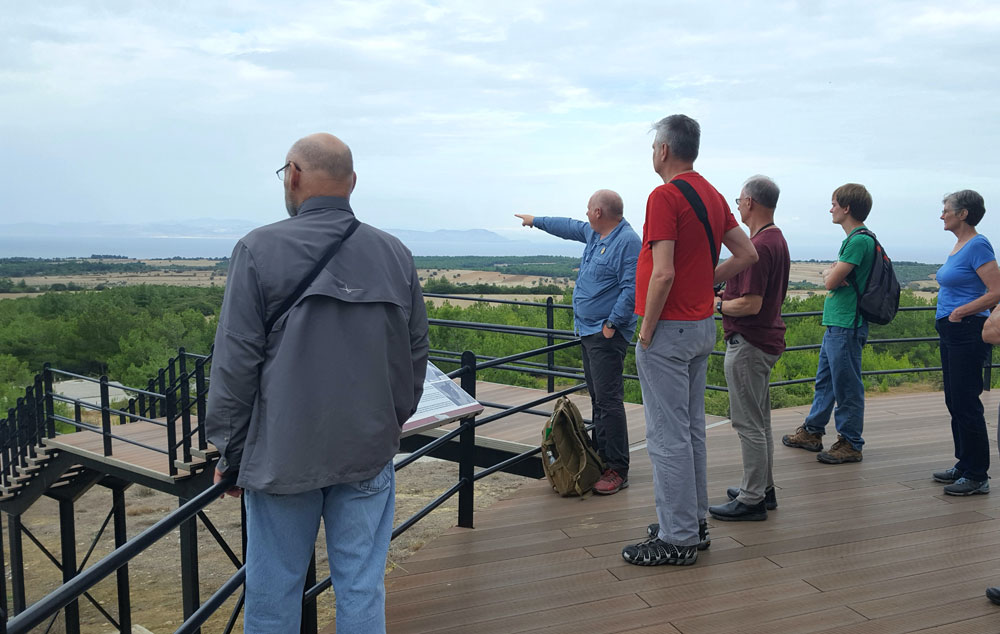
From the hotel we set off to Achi Baba ridge, one of the primary Ottoman defense posts of the Gallipoli campaign that towers over the village of Alçıtepe, formerly named Krithia. From this point, the landing beaches and respective battle sites of the British, ANZAC (Australia and New Zealand Army Corps) and French troops are visible in the distance, as are the arches of the Çanakkale Martyrs’ Memorial. The spot where we stood, amid hilly, densely forested terrain, was a primary target for the Allies to capture within the first 24 hours of landing at Cape Helles (Sedd el Bahr) on April 25, 1915. The Ottomans never lost this position.
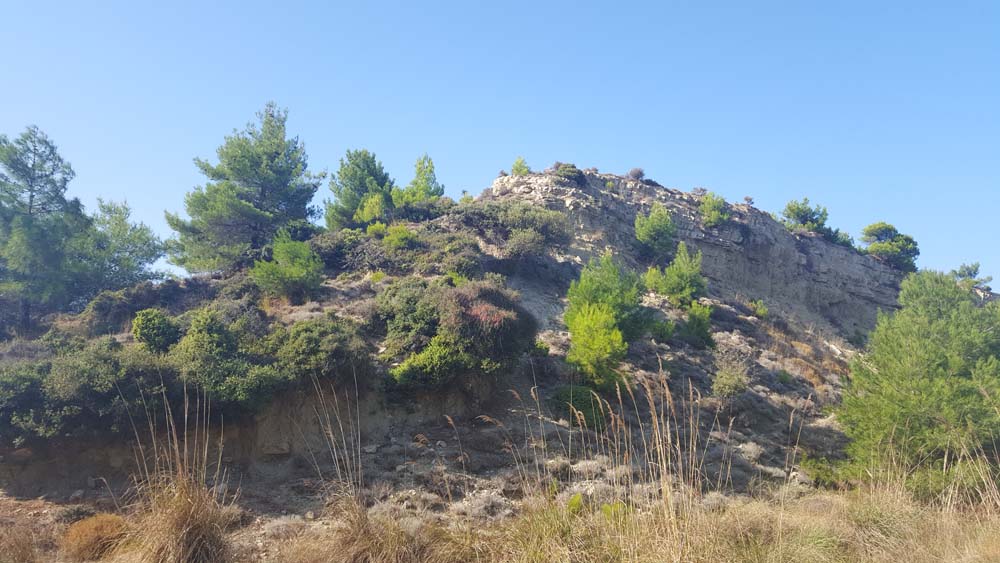
“If you look towards Sedd el Bahr, from where you are now, you can completely see the Helles Front where heavy fighting took place between the Turks and the British and the French for the control of this hill. Never forget that the territory you see in silence and peace today was like a hell made from a rain of fire and steel in the year 1915. Against those who created this hell, the Turkish soldier shielded his country with his body everywhere: in the gullies, and valleys, on the hills, and slopes extending towards Sedd el Bahr. Tens of thousands of them are lying buried under this soil. May they rest in peace.” — Excerpt from the information plaque at Achi Baba ridge in Alçıtepe.
We then went to the Lancashire Landing Cemetery where the graves of 1,114 identified men reside, including that of W.S. (William) Kenealy of the 1st Lancashire Fusiliers, who was one of six of his Regiment awarded the Victoria Cross during the landing.
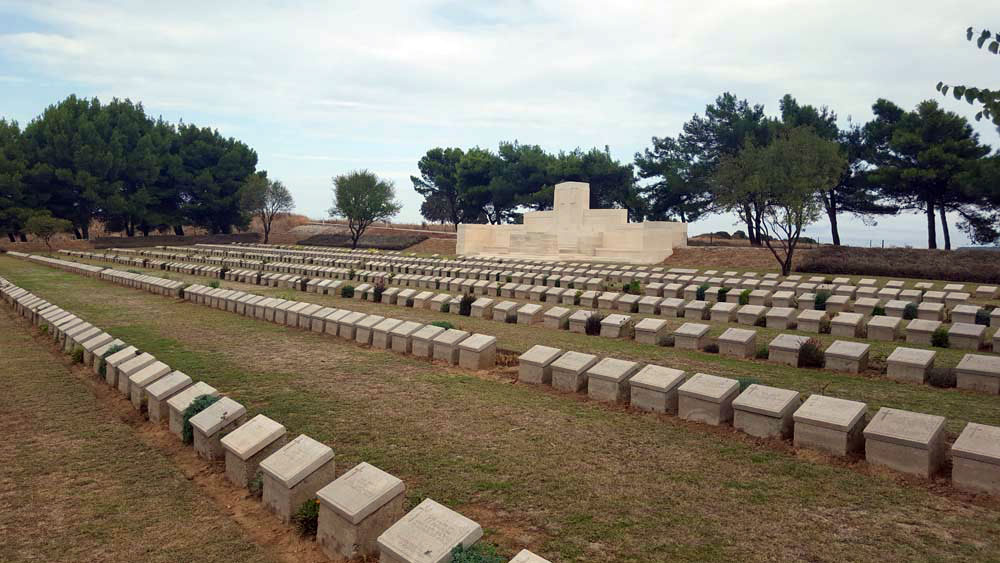
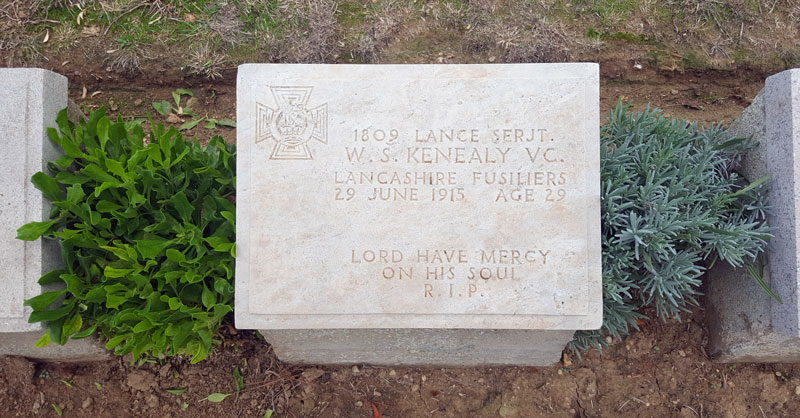
The British and ANZAC cemeteries on the Peninsula were constructed and continue to be maintained by the Commonwealth War Graves Commission (CWGC), formerly known as the Imperial War Graves Commission.
Honoring the men who sacrificed their lives for the Commonwealth while respecting the local culture, the design (by famous Scottish architect Sir John Burnet) of the cemeteries and gardens in this region feature unique headstones that are lower and primarily horizontal, while retaining a personalized engraving such as a Christian Cross, Star of David, Victoria Cross if a recipient, or Quranic verse. An irrigation system is installed in every row, nourishing the live plants between each grave.
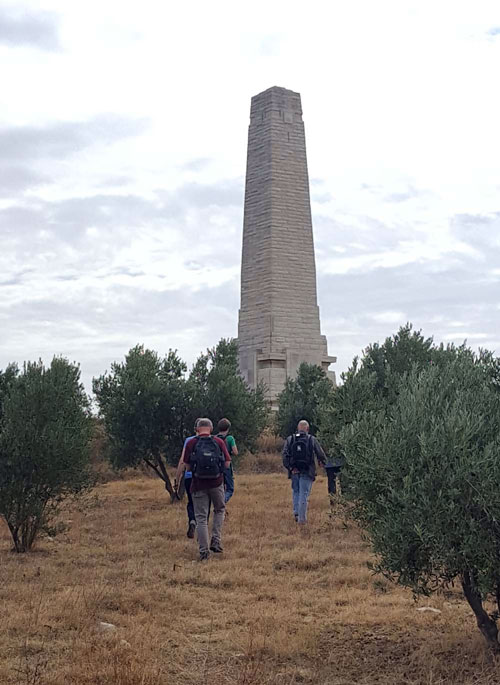
En route to the Helles Memorial for the missing Commonwealth soldiers, we stopped at W Beach, one of the Allied landing sites. Lodged in the sandbank was the rusty ruin of a “canteen” — a fresh water supply boat. Intentionally left behind, there are many others around the coast.
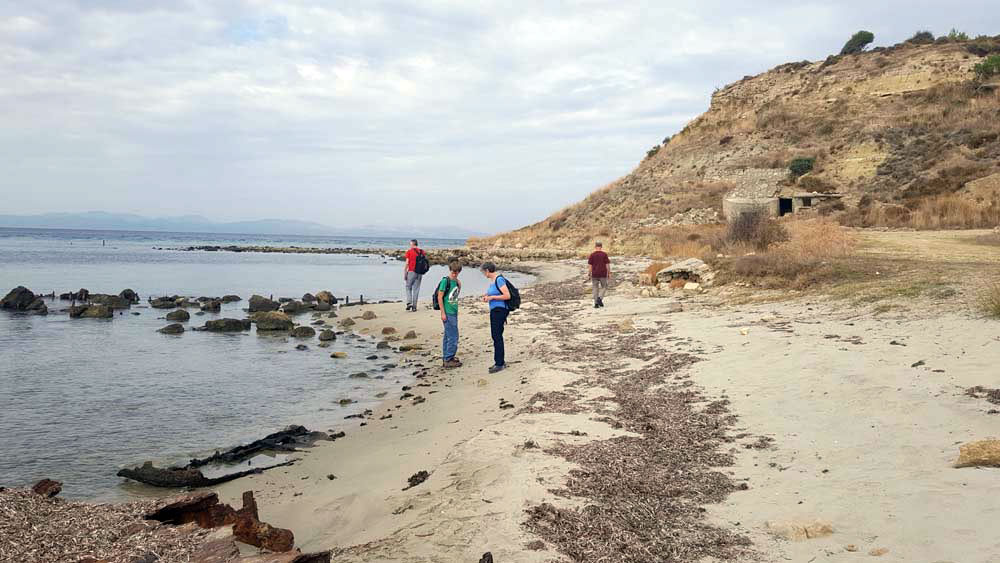
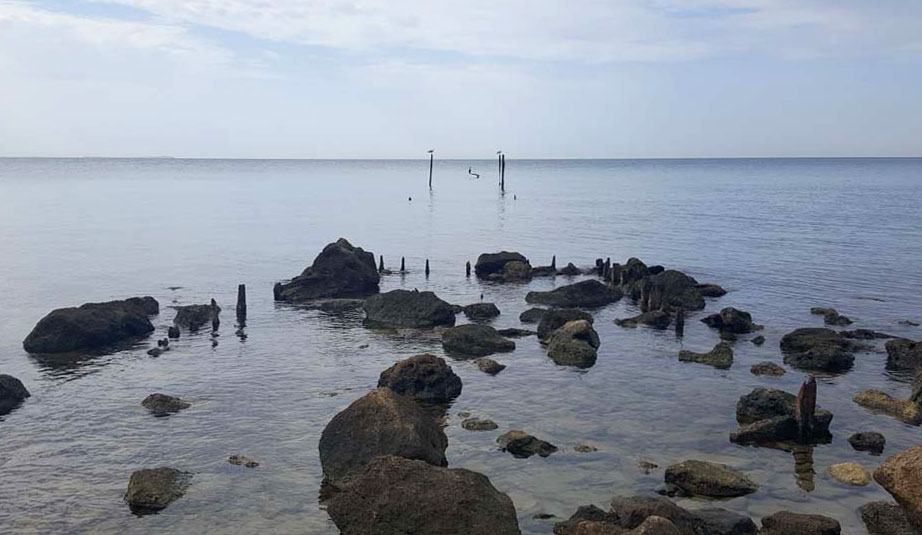
Crossing a barren field that served as an emergency landing zone during the war and then climbing up bumpy slopes fragrant with wild rosemary and thyme, we arrived at the Helles Memorial just as the call for midday prayer reverberated over the hills. Lining the walls of the Memorial are the names of over 20,000 men missing in action, lost or buried at sea, listed in order of rank. Included on the wall is Clive’s great uncle, Private George S. Miller of the 5th Battalion Norfolk Regiment.
After lunch, we finished the day in Gully Ravine, stopping at Y Beach. Due to the lack of open ground, the forested area was ideal for shelter, particularly for Allied medical camps. The Battle of Gully Ravine, which raged in late June 1915, created another Victoria Cross recipient— 2nd Lieutenant George Raymond Dallas Moor of the 3rd Battalion, The Hampshire Regiment. Clive read the account from the diary of Captain Beverly Ussher, Leinster Regiment, an eyewitness.
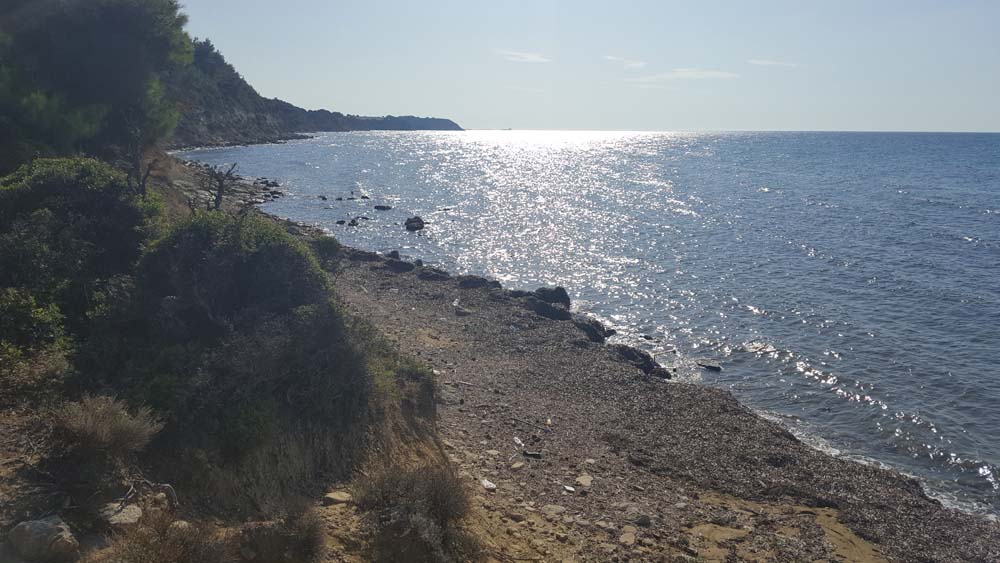
Day 3: Anzac Cove
Heading to Anzac Cove, we first ferried to Eceabat to explore Tarihe Saygi Parki, or Respect for History Park. Within the square are busts of prominent Turkish military officials from the Gallipoli campaign, a scale-model of the region where fighting occurred and a life-size model of Ottoman and ANZAC soldiers engaged in trench warfare. Overlooking the display is a bronze statue topped with Mustafa Kemal Atatürk, the founder and first president of modern Turkey. Spiraling down the rest of the sculpture are other symbolic figures of the war: Turkish soldiers, an Australian soldier, a British soldier, an Indian soldier, a New Zealand soldier and a mourning Turkish mother.
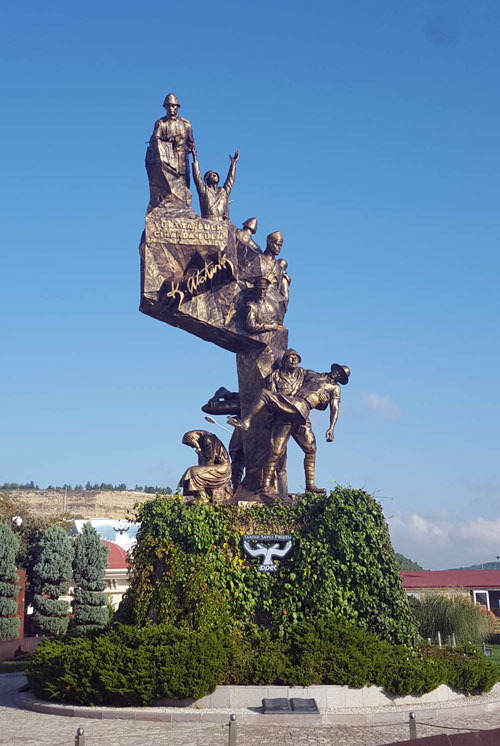
“Mehmetçik [a term used for a Turkish soldier in WWI, similar to ‘Doughboy’, ‘Johnnie’ or ‘Digger’] figure that carries a wounded Australian hero in his arms in order to treat him is a double figure that expresses the fact Turkish soldiers have a spirit that is broken by the death of his enemy.” — Excerpt from the sculpture label.
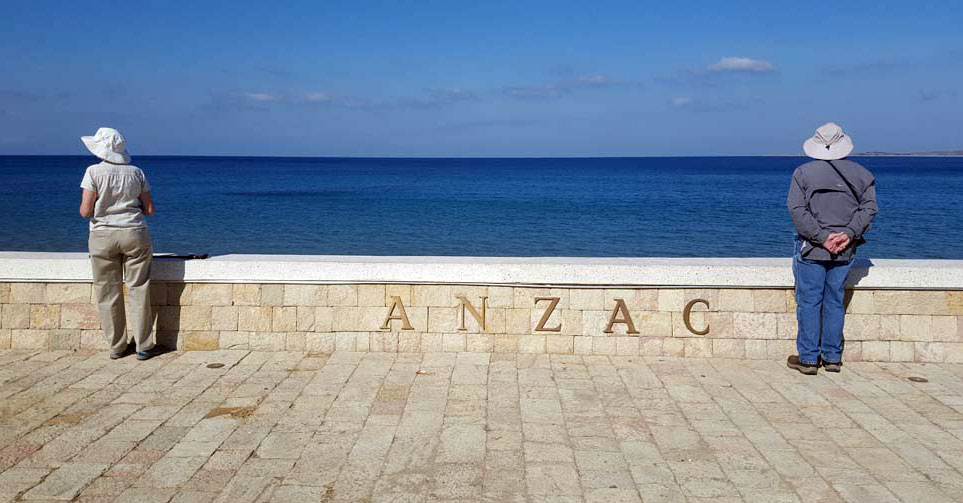
From there, we drove to Anzac Cove, where we walked along the coast to Ari Burnu Cemetery. A group of roughly 20 Turkish school children on a class field trip soon joined us in browsing the headstones. The reverence that the Turkish people have for the war dead—most notably for soldiers who fought as “an enemy”—is moving, especially among the younger generation.
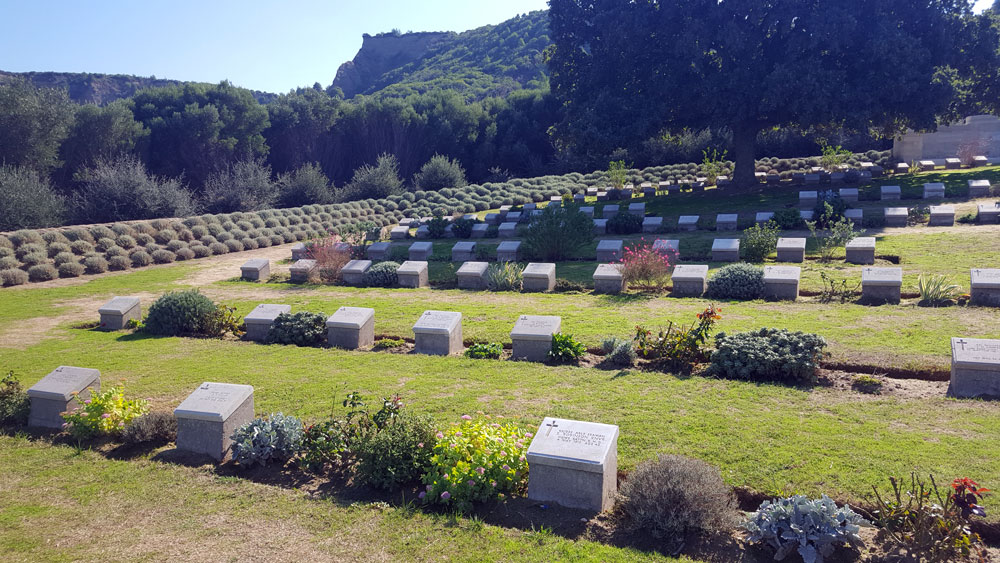
Meandering from Ari Burnu, we went to Beach Cemetery to see arguably the most visited grave on Anzac Cove—that of Pvt. John Simpson Kirkpatrick, “the man and his donkey” who transported the wounded to safety while under fire. His image, famous in Australia, has been replicated in bronze and even made into a postal stamp.
On the way to Plugge’s Plateau Cemetery, we paused at a monument with one of Atatürk’s most famous quotes.
“Those heroes that shed their blood and lost their lives…You are now lying in the soil of a friendly country. Therefore rest in peace. There is no difference between the Johnnies and the Mehmets to us where they lie side by side here in this country of ours…you, the mothers, who sent their sons from far away countries wipe away your tears; your sons are now lying in our bosom and are in peace. After having lost their lives on this land, they have become our sons as well.” — Mustafa Kemal Atatürk, 1934.
Photographs and portraits of Atatürk hang in almost every building in Turkey. Leading the Ottoman Army to victory as a commander during the Gallipoli campaign, he is credited for securing the future of an independent Turkish nation after the fall of the Ottoman Empire. His last name translates to “Father of Turks.”
Weaving around Shrapnel Valley Cemetery to Plugge’s Plateau Cemetery, we then ascended a steep, windy ridge to get a breathtaking view of the Shrapnel and Monash Gullies, with the Turkish Army’s 57th Infantry Regiment Memorial barely visible at the top of the hills.
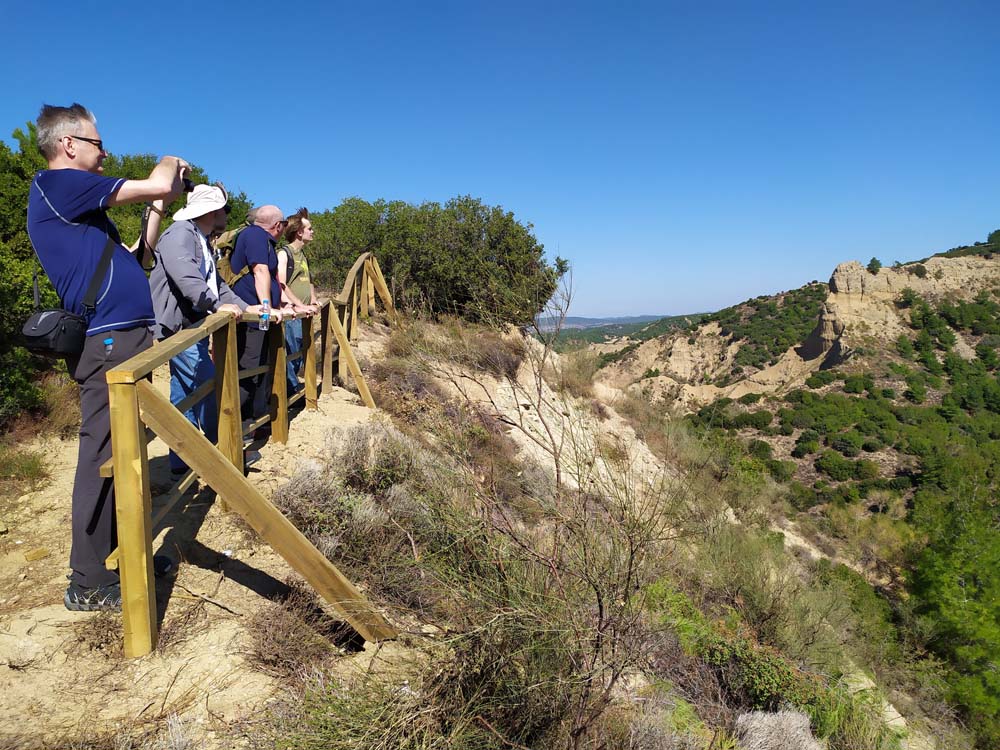
Wonder and awe followed us to Lone Pine Memorial and Cemetery, where we walked through a cratered hillside of Ottoman trenches overlooking the Aegean Sea. Recently excavated, the trenches were embedded with bullet shells and—incredibly—pottery fragments dating to ancient Greece.
Perfumed by the rosemary planted between its headstones, the Memorial and Cemetery commemorates 1,167 soldiers—504 of them with unidentified graves. The Battle of Lone Pine in early August 1915, though an ANZAC victory, resulted in some of the highest casualties of the Gallipoli campaign, with over 2,000 ANZAC troops killed or wounded.
“There's rosemary, that's for remembrance. Pray you, love, remember.” — William Shakespeare, Hamlet, 4.5.151-153.
We passed through Johnston’s Jolly and the 4th Battalion Parade Ground Cemeteries before reaching the 57th Infantry Regiment Memorial of the Turkish Army. These soldiers were the first to combat the Allies during the April 1915 landings and, for the rest of the Gallipoli campaign, primarily fought against Australian and New Zealand forces. Over 1,800 soldiers who died in action are commemorated on the headstones of symbolic graves—none containing remains—in the Memorial, where a statue of Turkey’s oldest veteran of Gallipoli, Hüseyin Kaçmaz, who died at 110 years old in 1994, stands at the entrance.
The day ended at The Nek. On Aug. 7, 1915, nearly 600 soldiers from the 8th and 10th Australian Light Horse Regiments charged up a ridge to an area roughly the size of a tennis court, only to be cut off by Ottoman gunfire. Of the 326 soldiers buried here, only 10 have identified graves.
The cemetery overlooks Suvla Bay and Salt Lake, where we spotted migrating flamingos wading in the water. At sunset, the leaves and flowers across the gullies ignited in an orange glow. The burial ground darkened, but the memorial’s inscription, “Their Name Liveth For Evermore” burned in the shadows. We stood, silenced by the beauty of—and equally, horror entombed within— the land.
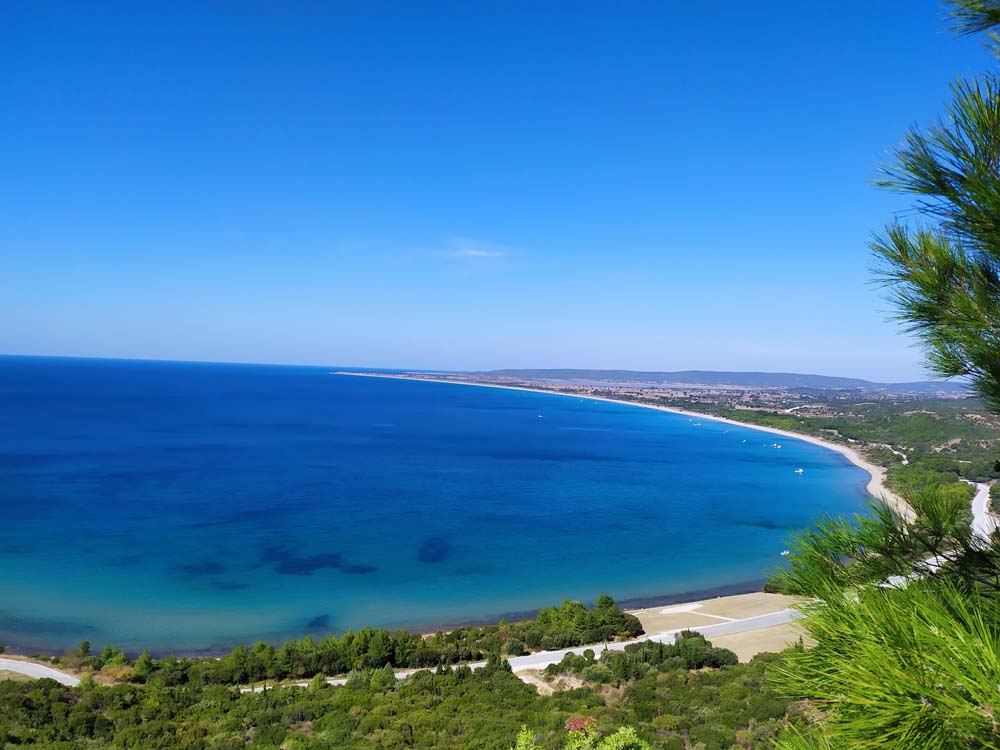
Day 4: Suvla Bay
At some moments, the only way to discern the sea from the sky was by wisps of clouds or a distant Greek island on the horizon. The weather, like it had been every day this week, was sublime on Suvla Bay.
This coastline, the primary landing location for the Allies in April 1915, was also where the Allies began evacuating Gallipoli. That operation—first at Anzac Cove then Suvla Bay—began on Dec. 20, 1915.
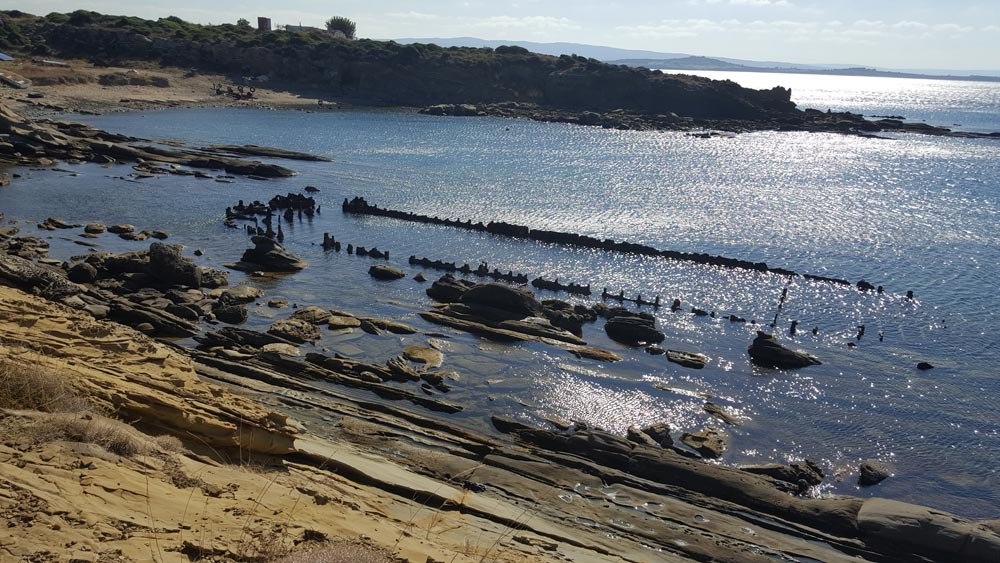
By pushing inland from the beaches, the Allies hoped to trigger Ottoman reinforcements to counter their attack and, by doing so, relieve the fire on the men fighting up in the hills. We studied those entries and exits while meandering to a nearby fisherman’s garden. Rusting below the cliffside were the ruins of a supply ship abandoned during the withdrawal.
From the Bay we headed to Hill 10 Cemetery. On Aug. 7, 1915, the 9th Lancashire Fusiliers and 11th Manchesters captured Hill 10—after mistakenly taking the neighboring Hill 8. The soldiers initiated a bayonet charge to secure the correct location. Among the 549 identified men buried in the cemetery is Second Lieutenant E.Y. (Edward) Priestman of the 6th Battalion York and Lancaster Regiment, a head Boy Scoutmaster and skilled cartoonist from Sheffield, England. He was last seen engaged in hand-to-hand combat.
About a mile northwest through farmland, we came to the space of the 5th Battalion Norfolk Regiment—most famously known as the “Lost Sandringhams.” These men, still ill from their journey, arrived in Gallipoli on Aug. 10, 1915. They were thrown into battle two days later, joining the Suffolk and Hampshire Regiments to make the larger 163rd Brigade.
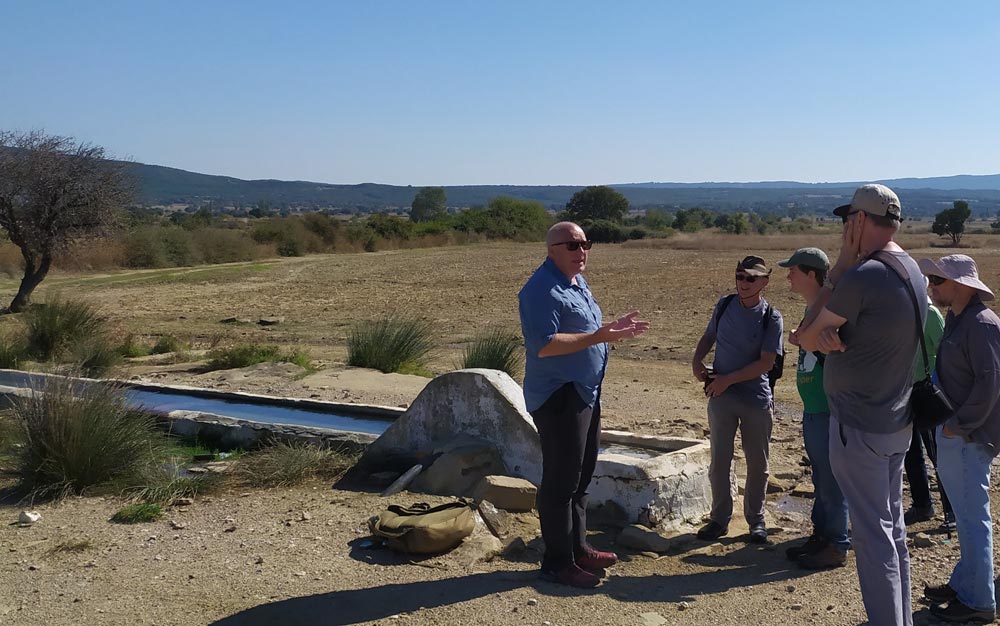
Somehow separating from the Suffolks and Hampshires, the Norfolks charged ahead into a “fog of war” against the Ottomans. Amid heavy artillery and sniper fire, the Norfolks pressed forward, pushing the Ottomans further inland. When the fighting ceased and the smoke cleared, there were no sign of the regiment. Among the missing men was Clive’s great uncle—the namesake of his son—Private George S. Miller, whose name we had read on the Helles Memorial on the tour’s first day.
No one knew their fate. Reports suggested the Norfolks were swallowed by a thick, cigar-shaped cloud during the battle—a meteorological phenomenon that had actually occurred in the area, but on Aug. 21 instead of Aug. 12. Some Ottomans rumored them to be snatched from the field by the hand of Allah.
The fighting grew hotter, and the ground became more wooden and broken. At this stage many men were wounded, or grew exhausted with thirst. These found their way back to camp during the night. But the Colonel, with sixteen officers and 250 men, still kept pushing on, driving the enemy before them. Amongst these ardent souls was part of a fine company enlisted from the King’s Sandringham estates. Nothing more was ever seen or heard of any of them. They charged into the forest and were lost to sight or sound. Not one of them every came back.” Sir Ian Hamilton, Commander of the Mediterranean Expeditionary Force, Dec. 11, 1915.
Some closure was granted nearly four years later when, in 1919, a Turkish farmer found over 150 bodies scattered in his land—an area approximately the size of nine football fields—after a heavy rain. The farmers exhumed the bodies for British personnel to bury at Azmak Cemetery. A cap badge found with the remains confirmed the men to be with the lost regiment, but only one man—Private John Barnaby—was able to be identified.
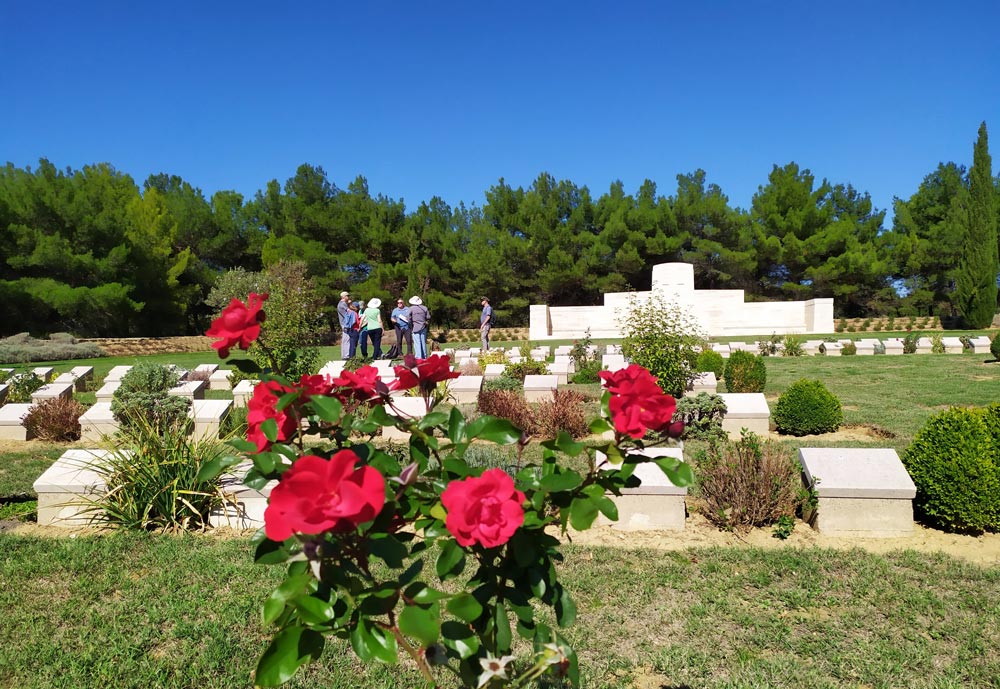
For lunch we picnicked outside of a World War I museum in Büyük Anafarta, curated by local farmer Özay Gündogan. The collection focused on the campaign in the Suvla region and Ottoman involvement in the war, but also featured artifacts from the Allies—including fragmented pairs of false teeth from British soldiers, commonly damaged by hardtack! It was a refreshing perspective.
“My village helped Mustafa Kemal Atatürk make his name in the fighting of 1915 during the Gallipoli campaign in the Anafarta sector when he was appointed the Anafartalar Group Commander, with his victory being taught in school and history books to this day.
“However, I felt that something was lacking. My beloved village was a part of the region where some of the bloodiest fighting of the campaign took place…As a citizen sensible of fulfilling my duty and seeing the need for the story of these war relics to be told to younger generations, shedding light onto the past and the future and to bring history to life, I wanted to display the objects I have collected with much material and spiritual effort…” — Özay Gündogan, Museum curator.
In the last hours of our day, we trekked through a family farm to view Salt Lake from the perspective of Ottoman defenses before passing through Green Hill Cemetery. On our way back to the bus, we strolled alongside a shepherd and his grazing flock, their bells tinkling with each step.
Day 5: Chunuk Bair
We had glimpsed the Çanakkale Martyr’s Memorial from the top of Achi Baba on our first day. Though tiny from a distance, it is enormous. Perched at the tip of Morto Bay at 137 feet tall, it can be seen from several areas on the peninsula and when sailing into the Dardanelles. Leading up to the Memorial are immaculate red rows of symbolic graves with no remains. Ordered alphabetically by city and each listing 36 names, they commemorate over 250,000 Turkish soldiers who fought in the Gallipoli campaign.
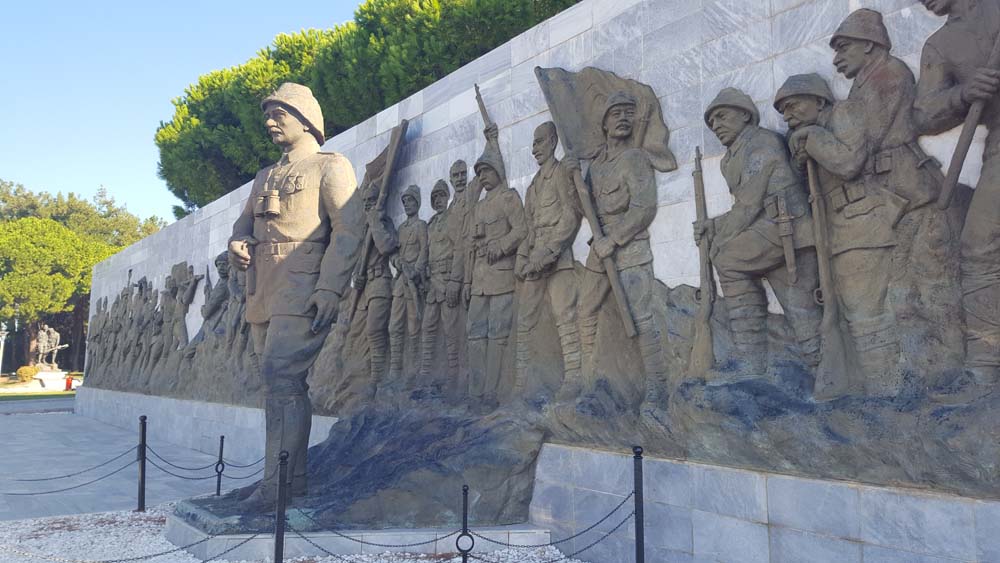
Adem gathered us around the lone grave of Meçhul Asker, which stands closest to the Memorial. Asker’s grave contains the only human remains in the Memorial, returned to Turkey from Australia in 2003. Adem never vilified the ANZAC soldier who took the human relic as a souvenir of action during the war. Adem, in sharing the brutal history with us with empathy emphasized that “[t]errible, unimaginable things happen in war that affect the mind.”
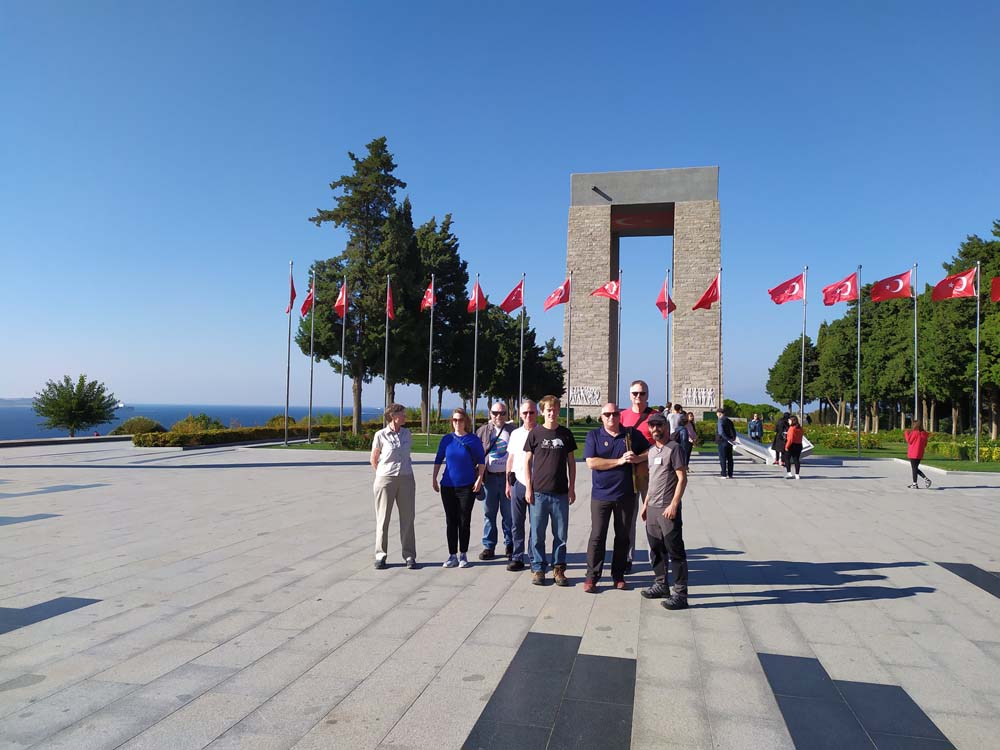
From the Memorial we went south, returning to Cape Helles to visit the Morto Bay French Cemetery. A monument representing a lighthouse looms above the 3,236 graves and four square ossuaries containing the bones of nearly 12,000 unidentified French soldiers. The officers lay in their own plots while the graves of enlisted men are uniquely marked with a barbed wire fence post. Christian soldiers’ posts are welded crosses; Muslim soldiers are marked by a single, straight post with a diamond nameplate; and Jewish soldiers have a single post with a heart-shaped nameplate. Despite diversity in rank and religion, all men have the same inscription: Mort pour la France, or Died for France.
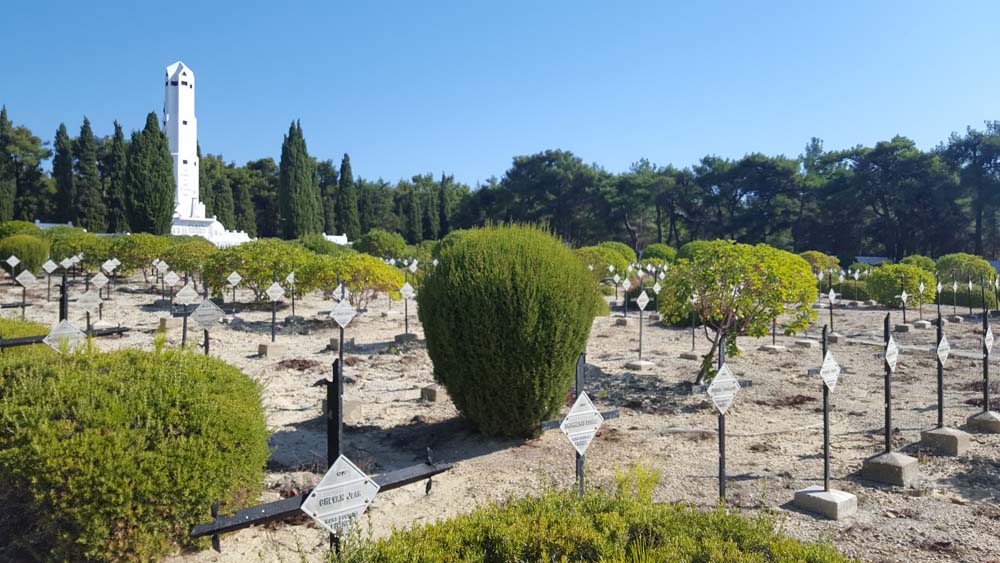
We stopped briefly at the secluded gravesite of Lieutenant Colonel Charles Doughty-Wylie of the Royal Welsh Fusiliers—the highest-ranking recipient of the Victoria Cross during the Gallipoli campaign—who was killed by gunfire from retreating Ottoman soldiers only a day after the April 25 landings. Afterwards, we toured four artillery guns left behind by the French during the evacuations in a now-empty field. They were intentionally damaged so that the Ottomans could never reuse them. In their pits we found bits and pieces of rum jars, bullet shells, and the cap of a beer bottle.
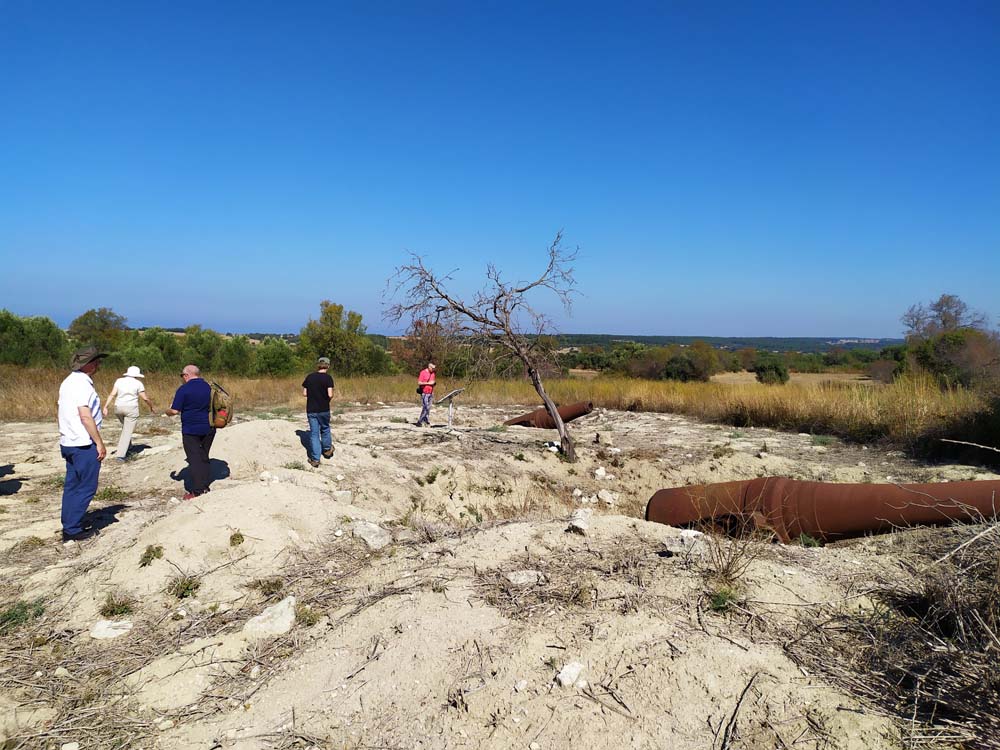
Arriving at Twelve Tree Copse Cemetery, we were sadly reacquainted with Captain Beverly Ussher—whose diary we had read on the first day—and then were introduced to Second Lieutenant Alfred (A.V.) Smith, East Lancashire Regiment, a Victoria Cross recipient.
After lunch, we headed to Chunuk Bair to trace the Allies’ failed attempt to capture the hill in August 1915. Beside the New Zealand Memorial—one of four on the peninsula dedicated to fallen New Zealanders (Kiwis) with no identified graves—is a tribute to Atatürk. This battle was an auspicious one for the Ottomans, as not only did they win and hold their position until the Allies evacuated from Cape Helles in December 1915, but Atatürk evaded death.
“I told them [the Commander of the 8th Division and other officers] that I have total faith in us and I know we will defeat the enemy. However, don’t hurry, firstly, I will go forward and when I raise my whip to give the action sign, you will attack all together. I wanted them to inform the soldiers about that. It would be a descent. I walked through to the enemy silently by 20-30 metres. There was absolutely no sound at Chunuk Bair where there were thousands soldiers. Lips were praying quietly in this hot night.
I paused, lifted my whip over my head and rotating it before bringing it down rapidly. Bedlam broke loose at 4:30 a.m. The English were in for a rude awaking. Sounds of ‘Allah, Allah’ tore the skies in the darkness over the front. Smoke covered all sides and the excitement dominates everywhere. The enemy’s bombs tore deep holes in the battlefield, shrapnels and bullets drop like rain from the sky. A piece of shrapnel suddenly hit me over my heart. I was shaken. I put my hand on my chest. There was no blood. Nobody except Lieutenant Colonel Servet Bey saw the incident. Lifting my finger I commended him not to make a sound. If it was heard that I had been shot, it would cause mass panic at the battlefront. The pocket watch which was over my heart had been shattered that day I fought until the evening with even greater passion and ambition, commanding my troops. The shrapnel however had left a deep red mark over my heart which didn’t recover for months.” — “The Moment Mustafa Kemal was Granted to Our Nation (With His Own Words),” inscription at Chunuk Bair.
We descended the hill and trekked into the woods west of the Memorials to reach The Farm Cemetery, the flattest, clearest strip of land within the ridges and gullies. One of the most difficult cemeteries to visit because of the rugged terrain, it hosts 652 soldiers, only seven of which have identified graves.
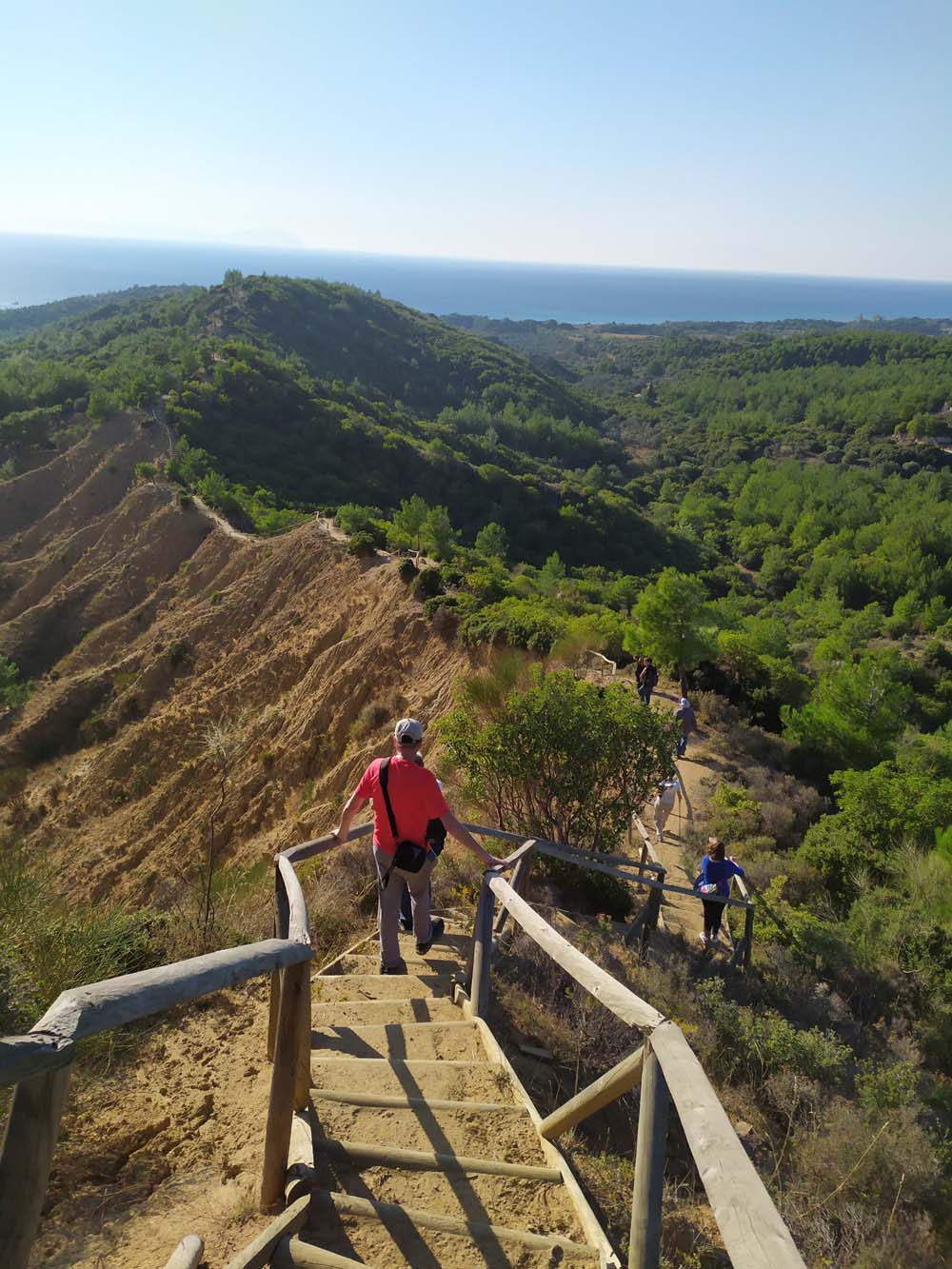
Hiking further up Rhododendron Ridge we glimpsed Big Table Top and Little Table Top, the flat-surfaced hills New Zealanders used to access the Ridge and ascend Chunuk Bair in August 1915. The soldiers climbed these trails during the night, dodging spotlights, to avoid the Ottomans. From our vantage point we saw the tips of the Memorials at Chunuk Bair and the Sphinx and shoreline at Anzac Cove, where we began our tour, bringing everything full-circle.
The memory of the Great War is intrinsic to the nature of Çanakkale, its story written in the geography of the land and on the hearts of the people who both live and come to commemorate here. The war is core to Turkish national identity. Here, remembrance is almost as involuntary as breathing, and every ground—whether it cradles the remains of ancestors or enemies—is considered sacred, proving that forgiveness doesn’t require one to forget.
